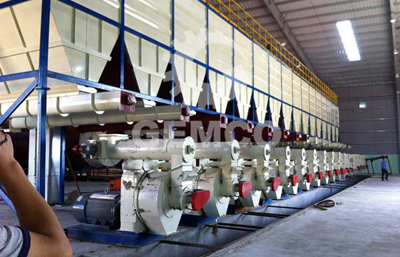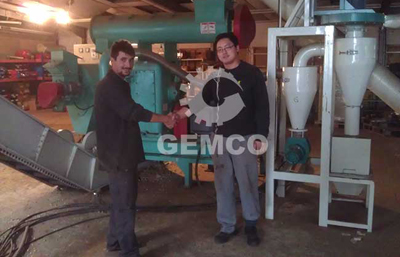Wood pellet market in Europe, North America and Asia
Global wood pellet consumption
Since the 21st century, the world’s pellet market has witnessed significant growth. As statics show in Europe Pellet Conference, the global wood pellet consumption in 2000 is 1.7 million ton, while in 2015 the number is 28 million ton, with 15 million tons for heat supply and 13 million for power plant.
The top 10 wood pellet consuming countries are England, Italy, Denmark, Germany, Sweden, Korean, Belgium, French and Austria.
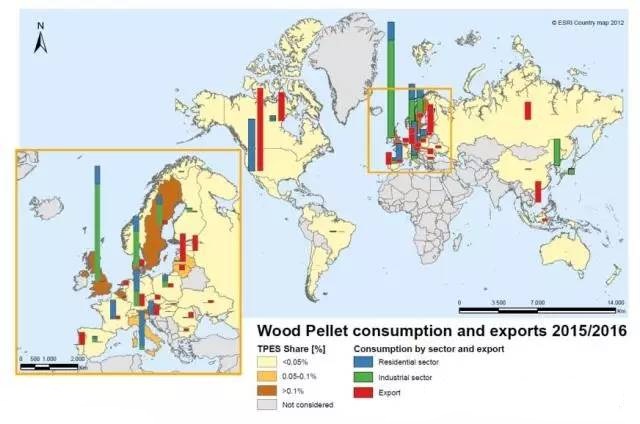
The most prominent growth of wood pellets consumption takes place in Europe, as a result of their state subsidies and climate policy. Currently, Europe takes up 80% of the world’s wood pellet consumption.
Wood pellets are mainly used for home heating and power generation in Europe. England remain as the largest wood pellet consumer. Under the support of government, many coal-fired power plants are transformed into biomass pellet plant.
Other major wood pellet consumers are Italy, Sweden, Denmark, Germany, Belgium, and Holland. Wood pellets are mainly used for power generation in England, Belgium and Holland, while they are used for heating supply in Italy and Germany. Because the government lay high tax on coal, oil and gas.
The second largest wood pellet consumption place is North America. It takes up 11% of the world’s total wood pellet consumption. Wood pellet consumption also grows rapidly in Asia. Japan and Korean are the major wood pellets buyers.

Global wood pellet production
In the past 17 years, global wood pellets production also increased continuously. An Ukraine biofuel industry analyzer claim that the growth of wood pellets production is due to favorable Political situation.
Europe remain as the world’s largest wood pellet producer and supplier, taking up 51% of the market share. The largest wood pellet production country is Germany. Then follows Sweden, Latvia, and Austria. These 4 countries are ahead of other European countries.
America is only secondary to Europe, taking up 27% of the total production. And Canada is the third producer with 7% market share. On the other hand, America and Canada is the world’s largest wood pellet exporter. Most of its wood pellets are exported to EU. Canada is the second largest exporter. British Columbia is the largest pellets production place in Canada.
Global wood pellet market demand
The wood pellet market contains 2 fields: industrial wood pellets used in power plant as a substitute for coal, and heating pellets used in pellet stove and boiler.
Both industrial pellets and heating pellets have significant growth in the past 10 years. In the last 4 years, the average growth rate is 10%. And the growth will continue in the next decade. In 2016, the overall demand for wood pellets is about 13.8 million ton. Up to 2025, the annual wood pellets demand is expected to grow by 2.7 million tons every year.
The wood pellet demand in Europe is going to hit a plateau by the year 2020. At that time, Japan and Korean will be the major growth impetus. Canada’s demand for industrial wood pellets keep on growing in the future, driven by the state “decarbonization” policy.
In the next several years, the growth of wood pellets will take place mainly in Japan, Korean and China. Korean is the largest wood pellets importer in Asia. The government planed to add 25% investment to alternative energy. It is predicted that the import volume of wood pellets will reach up to 8.5 million ton by 2022.
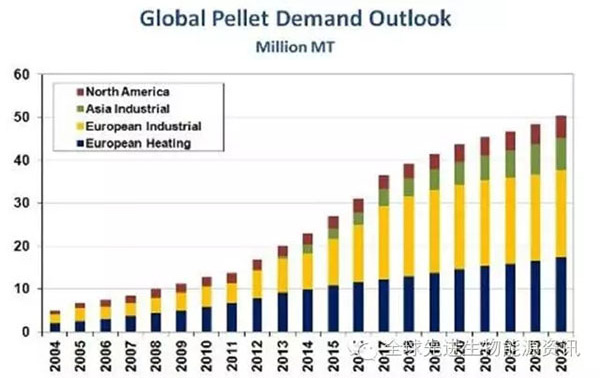
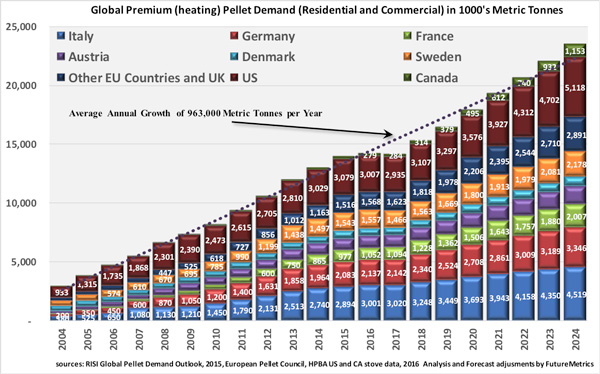
What influence the wood pellet market?
With the increasing production of wood pellets, pellets supply in some market has exceed demand. This is because the winter temperature is higher than former years, and the price of crude oil goes down. However, when the new biomass pellet plants come into use, they will create new demand to offset the excess capacity.
The heating pellets industry grows steadily in the past decade. The growth of heating pellets is driven by the price advantage. In most places, wood pellets are the lowest-cost fuel. But when the price of crude oil and propane go down, they will challenge the status of wood pellet fuel. Based on the price trend of oil in 2018, heating pellet market will regain its momentum.

In America, the growth of heating pellets intimately correlate with the price of heating oil and propane. The demand of wood pellets and pellet stove goes up along with the price of heating oil. Climate is always a influencing factor, but pellet demand depends more on oil price when it is over $63.
Government policy also have impact on industrial wood pellet market. Canada has raise the price of carbon to restrain carbon emission. Alberta province has enacted laws to stop power generation from coals by 2030. In many European countries, governments levy high taxes on gas, oil and coal and give support to renewable energy.
We receive enquiries in English, Español (Spanish), Русский язык (Russian), Français (French) and العربية (Arabic). Our professional team will reply to you within one business day. Please feel free to contact us!
